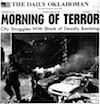Kelly Dyer Fry can’t remember the day of the week that Timothy McVeigh parked a van outside the Alfred P. Murrah Federal Building in Oklahoma City, detonated the explosives inside and killed 168 people. But she remembers everything else.
“I even remember what I was wearing,” said Dyer Fry, who was then the features editor at The Oklahoman and is now the paper’s editor-in-chief. She wore a blue and white striped skirt and top. “And I remember thinking it’s time to switch to spring clothes.”
Dyer Fry was in The Oklahoman’s building that morning when she felt the building shake. She was on the ninth floor and thought that maybe a news helicopter had crashed into the building. She remembers Jim Argo, a photojournalist with the paper, walking down the hallway with a cup of coffee in one hand. It was a sonic boom, he said. They went to look out the window and saw a black cloud rising over downtown Oklahoma City.
“And he said ‘let’s go.'” Dyer Fry hesitated. “And I said, ‘I can’t. I’m a single mom with two little boys.'”
She headed downstairs and worked the phones and with reporters who came into the newsroom, shaken by the news. The paper had an interoffice memo system set up and through it, staff shared facts about the bombing.
From an April 19, 1995 story:
The bombing, felt throughout central sections of Oklahoma, shattered the downtown district and left a grieving state wondering why.
The explosion, shortly after 9 a.m., demolished about a third of the Alfred P. Murrah Federal Building, causing all nine stories, including a day-care center on the second floor, to “pancake” into a pile of rubble.
Workers in their offices tumbled out of the nine-story building to the street below. One man fell into the 30-foot-wide bomb crater.
Victims fled the building, their clothes ripped off by the blast. Others wandered in a daze. Some victims with gashes on their arms and legs, or with head injuries, blood streaming down their faces, sat on curbs, quiet and shocked.
Twenty years later, this isn’t just an anniversary story at the newspaper. It’s a day that brings back memories for the people who work there, many of whom were working that day, Dyer Fry said.
“We’ve been covering it for a long time,” she said, “and we cover it every year with respect and reverence.”
This year, that includes a look at how the paper covered the story 20 years ago, as well as a documentary, an interactive timeline and a special site with coverage of the 20th anniversary.
On Monday, Clytie Bunyan wrote a piece about the journalists who worked at the paper that day.
Until then, such tragedies happened only in far-off places, but we lost our innocence that day. We told “people” stories – stories about the lives of each victim – which became a standard for reporting on tragedies. Former Assistant Managing Editor Joe Hight, who led the team that reported on the victims, later worked with the Dart Center for Journalism to establish standards for interacting with trauma victims.
A lot has changed in 20 years.
“Journalism has changed. Our city has changed,” Dyer Fry said. “Our city has blossomed. Our city has really been very resilient, it kind of galvanized our city. We’ve seen tremendous growth here.”
She still feels torn about choosing to stay in the newsroom that day. She remembers not knowing what was going on. “I just knew it was big and it was bad and I just thought, I’m going to have to be one of the people that works in the office.”









